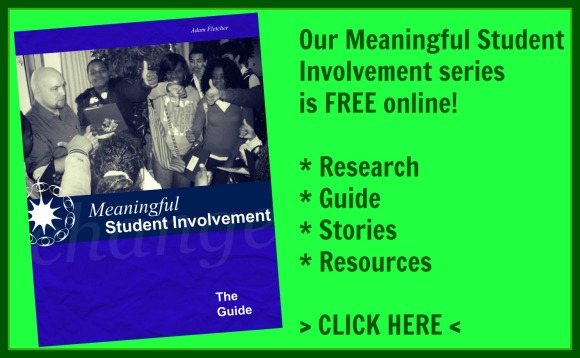The first form is individualized education planning, which is planning that affects only the student who is involved. The second form is institutionalized education planning, or planning that affects large numbers of students or the entire student body.
 Student Voice in Decision-Making from SoundOut.
Student Voice in Decision-Making from SoundOut.
Type 1: Individualized Education Planning
Imagine if you will, before the beginning of the school year, every educator receive a file. The student, their previous teachers, and their parents all participated equally in creating this file. In it is a description of the child, learning goals and objectives for the year, particular learning needs and focus areas, and past evaluations of the student is learning, completed by the student, their previous teacher, and their parents.
- The “Individual Education Plan” (IEP) is developed with every student, regardless of age, grade, ability, or achievement, focusing on the student as a partner in his or her own education.
- There are currently few schools developing IEPs for every student.
- The effectiveness of this approach to education planning has been proven for many years, and is largely undisputed.
- Students with disabilities have been using these tools successfully in many schools, with large increases in students’ focus and motivation, more support for students in mainstream classrooms, and more.
- With an IEP, the responsibility for a student’s progress is not just on the shoulders of the adults, but shared with the student.
- Students regularly become eager to track their progress in specific IEP objectives, such as reading speed and accuracy, sentence writing and paragraph skills, math fact fluency, self-control behaviors and self-advocacy.
Type 2: Institutionalized Education Planning
Educators and students alike face a variety of barriers to Meaningful Student Involvement in institutionalized education planning. Educators often exclaim that students have the “wrong” attitudes, are immature, and ill equipped for the responsibility of large-scale school planning. Students say that educators act intimidated by students, or do not value their experience.
Here are some examples of Meaningful Student Involvement in institutionalized education planning:
- Writing Curriculum
- Engaging Students on Purpose
- Students Involved in School Design
- Planning High School Learning
- Action through PICI
- Learning Units for Teachers
- Students Launch a School
- Elementary Students Revise Curriculum
For more information about engaging students as planners in classrooms, principals’ offices, school boards and education agencies, go here.
Related Articles
- Students as Education Planners
- Meaningful Student Involvement Planning Guide by Adam Fletcher for SoundOut
- Lesson Plan on Action Planning

